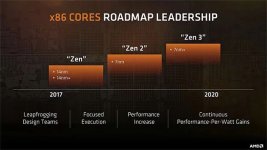Soldato

Source: Bits and Chips / TechPowerUpTechPowerUP | Posted: 17 October 2018 said:AMD "Zen" CPU architecture brought the company back to competitive relevance in the processor market. It got an incremental update in the form of "Zen+" which saw the implementation of an improved 12 nm process, and improved multi-core boosting algorithm, along with improvements to the cache subsystem. AMD is banking on Zen 2 to not only add IPC (instructions per clock) improvements; but also a new round of core-count increases. Bits n Chips has information that Zen 2 is making significant IPC gains.
According to the Italian tech publication, we could expect Zen 2 IPC gains of 13 percent over Zen+, which in turn posted 2-5% IPC gains over the original Zen. Bits n Chips notes that these IPC gains were tested in scientific tasks, and not in gaming. There is no gaming performance data at the moment. AMD is expected to debut Zen 2 with its 2nd generation EPYC enterprise processors by the end of the year, built on the 7 nm silicon fabrication process. This roughly 16 percent IPC gain versus the original Zen, coupled with higher clocks, and possibly more cores, could complete the value proposition of 2nd gen EPYC. Zen 2-based client-segment products can be expected only in 2019.

Last edited:



